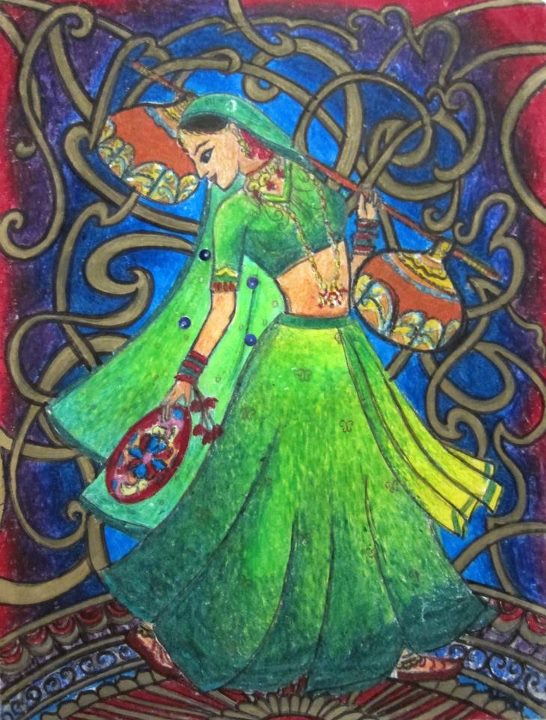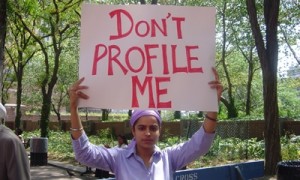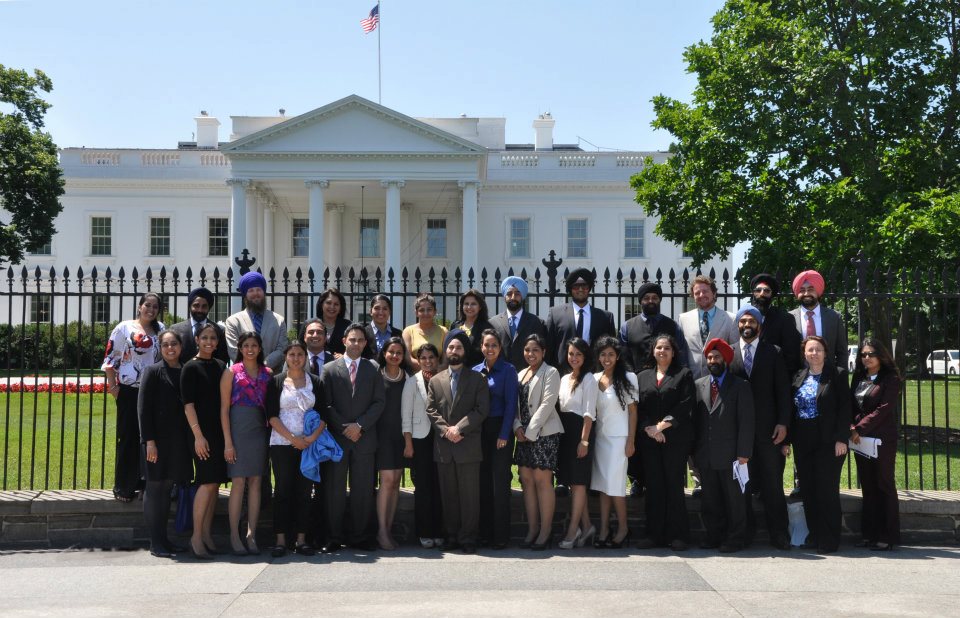
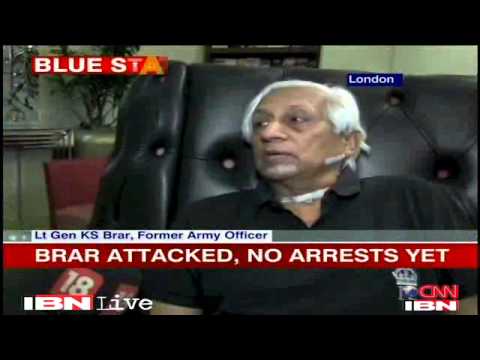 Yesterday’s news about the attack on KS Brar has excited, angered, inspired, and agitated many Sikhs throughout the world.
Yesterday’s news about the attack on KS Brar has excited, angered, inspired, and agitated many Sikhs throughout the world.
Many have questioned the Indian media’s initial assumption, before even the facts had arrived. Still others are wondering if the news is even factual. I have seen numerous postings on social media, believing that the attack was just a fabrication in order to make Sikhs appear ‘violent’ and ‘extreme’, especially after the recent goodwill expressed by some channels in the US and abroad after the recent Wisconsin Massacre. Finally, our brothers and sisters at Naujawani have written an intriguing article asking larger questions about a more sinister timing of all events (though not sure if I agree, well worth a read!).
I believe that the case of Kulbir Singh Barapind and Daljit Singh Bittu is extremely important, but that warrants a separate post. I will return to that issue at a future time.
Personally I am quite surprised that no names have appeared yet, as I figure someone would probably take credit and I wouldn’t imagine the names could be held a secret for too long within the community, especially if those that confronted him were young, as the claim is being made. Still I think that I want to take this conversation in a different direction. How do we ‘present’ SikhISM and its implicationsi?
 Co-blogged by Sanehwal and Mewa Singh
Co-blogged by Sanehwal and Mewa Singh
In an easily missed bit of North American Sikh intellectual bloodsport, IJ Singh and a graduate of UC Berkeley debated ideals about graduate education, the panth, and the academy. It is worth reading through for their different orientations towards the discussion, if at the very least to see how two people with very different positions in life (gender, education, class, age) interpret the issues at stake.
In IJ’s article, he mentioned the National Science Foundation Graduate Research Fellowship Program, an American government program that funds graduate research. I had to Wikipedia it. At the time I was an undergraduate interested in applying to PhD programs in the social sciences, and despite the wealth of resources at my university, I ended up scouring the internet for advice on how to successfully apply to doctoral programs that routinely get upwards of 400 applications for 5 or 6 seats. The National Science Foundation’s graduate research fellowship was part of the deluge of items to tackle: letters of recommendation, emails to potential advisors, picking programs, and the dreaded statement of purpose. To make matters worse, my primary advisor was on leave, and unlike many of my peers, I had few friends or places to turn where I felt comfortable getting honest and expert advice on how to craft applications that best demonstrated my accomplishments and abilities.
Guest blogged by Parvinder Mehta
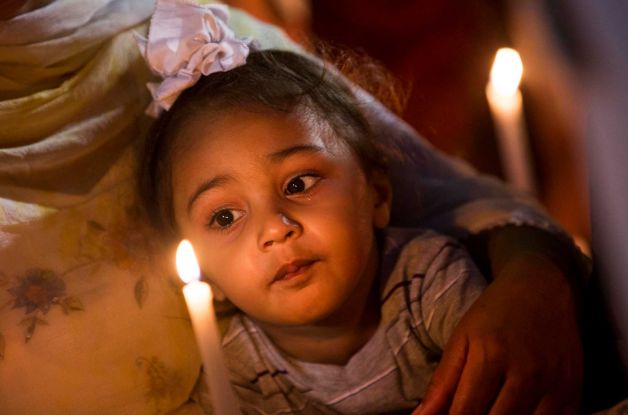 Amidst the barrage and frenzy of shock and surprise and the discussions about why the Sikh community has been targeted and victimized through history, I wonder how Sikh parents have tried to make sense of the massacre of six Sikhs and the suicide of the gunman who came with his hateful agenda to the Gurdwara in Wisconsin earlier this month. “How can one human kill another human being on purpose?” I am always haunted by this question. As a parent, I shudder at the thought of violence creeping up in our lives. It is tough explaining to your children why some people commit heinous crimes against innocent people and why some people do not like Sikhs or may have never known about Sikhs. Or explaining why a Michigan Gurdwara was vandalized last year and how ignorance can be a dangerous premise.
Amidst the barrage and frenzy of shock and surprise and the discussions about why the Sikh community has been targeted and victimized through history, I wonder how Sikh parents have tried to make sense of the massacre of six Sikhs and the suicide of the gunman who came with his hateful agenda to the Gurdwara in Wisconsin earlier this month. “How can one human kill another human being on purpose?” I am always haunted by this question. As a parent, I shudder at the thought of violence creeping up in our lives. It is tough explaining to your children why some people commit heinous crimes against innocent people and why some people do not like Sikhs or may have never known about Sikhs. Or explaining why a Michigan Gurdwara was vandalized last year and how ignorance can be a dangerous premise.
I knew I must tackle the endless questions that they would ask about why someone committed this heinous act. I knew I must not use any rhetoric of hate or fear when talking to my children, the same way as my parents had taught me. Terms like prejudice, bias, racism, and ignorance are part of my children’s vocabulary much sooner than I had hoped. As a teacher and a parent, as a proud and practicing Sikh, I have always shared the anecdotes from Sikh history with my children where courage, not fear, is the driving lesson. The crucial question that we, as Sikh American parents, are faced is how we reassure our children that such hate-driven incidents will never recur. What can we do as Sikh parents to promise our children a hate-free environment so they can assert their Sikh identities without fear?
This election year is a reminder that Sikh Americans need to participate more actively in civic and political life. In order for the government and the media to pay attention to issues affecting our community, we need to have a seat at the table where decisions are being made and ensure that our voice is included in any policy changes.
The following are two ways that individuals can take action to change law that would impact the lives of Sikh Americans in California. These actions are for individuals living in California, but similar actions can and will take place in other states at various times. California is the 8th largest economy in the world, so if these changes become law – then these actions are even more meaningful for the Sikh community. It will go down in history that Sikh Americans helped create change for not just our own community but other marginalized communities too.
The following two bills have already successfully passed through both the California Assembly and Senate. Much of the hard work has been accomplished thanks to advocates within the Sikh community, sangat members across the state and Sikh organizations such as The Sikh Coalition. The final step in this process is for Governor Brown to sign these bills into law. You can help by taking one small step for each bill – by simply contacting the Governor’s office. While Governor Brown has until September 30th to sign these bills into law, he can decide on the bills any day. We encourage you to take action today! Please leave a comment in the section below letting us know if you have taken action.
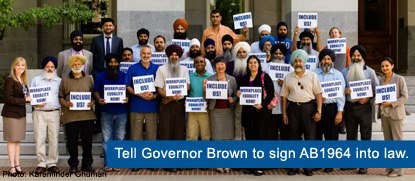 AB1964 – Workplace Religious Freedom Act: SIGN THE PETITION
AB1964 – Workplace Religious Freedom Act: SIGN THE PETITION
If this bill moves forward and becomes law, it will sharply reduce job discrimination against Sikhs and other religious minorities and guarantee equal employment opportunity to all workers in California.

SB1540 – Revised Curriculum Framework: History-Social Science: SIGN THE PETITION
This bill would authorize the State Board of Education to complete the revision process of the History-Social Science Framework for California schools. When completed, this framework will ensure that California students learn about Sikhism and Sikh contributions, thereby increasing appreciation for diversity and reducing ignorance of the sort that leads to bullying and bias.
We believe at the heart of each Sikh American woman, there are multiple love stories that inhabit the mind, body, and soul.
This one is for you dear Kaurs!
The first ever Sikh Women’s Love Anthology is being created and your voices are needed. This groundbreaking anthology will be a compilation of love stories written by and about Sikh women living in North America and will be published in the form of memoirs, creative non-fiction stories, and creative essays.
Sikh women have an incredible history of powerful and inspiring narratives – often heard through our oral tradition. This project is a way of documenting these narratives and providing a space for women in the Sikh community, connecting with one another to dialogue and document the complexities and nuanced experiences of love as we see it. Love can take many forms – “through lovers holding hands, singing a shabad, eating a good meal to nourish one’s body, hiking an unknown terrain, traveling a new country, holding a sick child close, fighting for civil and human rights or even embarking on the journey to falling in love with ourselves as women and human beings, spiritual beings” [from guidelines]. Love is at the core of our very existence as Sikhs.
This is a wonderful opportunity to pave the path for Kaur voices that we do not often hear. Sikh women who are dedicated to their families, their faith and their activism and manifest their love in dynamic ways. Yet their stories go unheard. Documenting one’s story provides for self-reflection and is “an act of resistance against social, cultural, media, and political forces that want to define women as less than humane“. This is an important way to chronicle narratives for future generations of Sikh American women and men.
Click below the break for submission details. For further information and full submission guidelines, please email sikh.lovestories[at]gmail.com.
Guest blogged by Amardeep Singh
Recently I found myself in the odd position of being, for a brief moment, a sort of spokesperson for the Sikh-American community in the wake of the terrible shootings at a Sikh Gurdwara in Wisconsin.

Page from the book, The Boy with Long Hair
It’s odd for me because I am a pretty secular Sikh, who doesn’t have an especially deep knowledge of Sikh history or theology. After my essay on “Being Sikh in America” appeared in the New York Times, a colleague at the university where I teach later invited me to give a talk on Sikhism for students at the university this fall, but I had to decline — I think others could probably do a better job. I also started saying no to interview requests and reprint requests once I felt that my main point — that we should be clear that we are “united against hate” had left its mark. And that’s just fine: while we are all still processing the horror of what happened in Oak Creek two weeks ago, it has been inspiring to see many positive and constructive voices from the Sikh community appearing in the American media.
The part that remains pressing for me as a parent is the issue I mentioned at the end of the post I wrote two weeks ago — how to talk to my children about either the immediate issue of racial and religious hostility, or even the broader question of how to educate them about Sikhism as a religion.
As I was raised, much of the heavy lifting with regards to religious education was done via Gurdwara Sunday school (in Silver Spring, MD), and various day camps for Sikh children. I don’t recall either of my parents actually sitting me down and saying, “ok, here is the story of Guru Nanak…” or anything along those lines. And as my own son becomes old enough to enroll in Sunday school at our own local Gurdwara, it’s tempting to simply continue that pattern to avoid certain uncomfortable questions (such as: “did that really happen, or is it make-believe?”). What is taught is often heavy on use of Janam Sakhis and a pretty narrow version of the accomplishments and doings of the various Gurus. And memorizing various numbers, names, and prayers: 10 Gurus, 5 Ks, Jap Ji Sahib. (No one succeeded, at that point, in teaching me much actual spoken Punjabi, so the memorization of Jap Ji Sahib was purely by rote — to impress the family back in India, maybe? I had very little idea of the meaning or context of anything I learned at Sunday school until I sought out that knowledge as an adult.)
Why isn’t that approach enough for me as a parent? Two reasons.
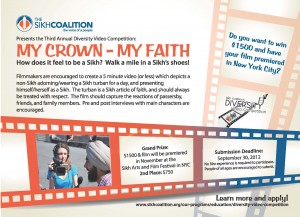 The use of social video sites by our community has seen an upward trend. Of course, many readers of this blog will instantly recognize individuals that have emerged in the last two to three years using YouTube and other social media sites – Mandeep Sethi, Humble the Poet, JusReign, and IISuperwomanII are but a few of the commonly recognized names from North America alone.
The use of social video sites by our community has seen an upward trend. Of course, many readers of this blog will instantly recognize individuals that have emerged in the last two to three years using YouTube and other social media sites – Mandeep Sethi, Humble the Poet, JusReign, and IISuperwomanII are but a few of the commonly recognized names from North America alone.
As it becomes more accessible, we are also seeing the emergence of more grassroots-level use of social video. This medium has allowed Sikhs, and particularly Sikh youth, to express themselves to an unprecedented audience size, and there are several organizations encouraging Sikhs to make use of this platform. For example, SikhNet has been running their Youth Online Film Festival since 2006, and the Sikh Coalition is also holding their third annual Diversity Video Competition for its third consecutive year.
Recently, Manbeena Kaur, the Sikh Coalition’s Education Director, was good enough to answer some questions about the use of social video for the purposes of Sikh education and awareness.
Needless to say, it’s been a tough week. I have been grateful for all the thoughtful writing my Sikh brothers and sisters have been putting out through the mainstream and independent media and all the important conversations that have been happening here at TLH and beyond.
That being said, sometimes it’s nice to take a few minutes away from the intense discussion and laugh a little. As Naunihal Singh noted in his recent (fantastic) column in the New Yorker, neither John Stewart nor Steven Colbert have made any mention of Oak Creek at all since the tragedy. Fortunately, there is a new, edgy late night talk show on FX called Totally Biased, hosted by comedian W. Kamau Bell and produced by Chris Rock, that did go there. And in a respectful way. No surprise, given that fellow desi Brooklynite Hari Kondabolu (who has a master’s degree in human rights from the London School of Economics) is a writer for the show. In this clip, Bell exposes the absurdity of some of the discussions in the mass media (and by politicians) about Oak Creek and the Sikh community. Hope you enjoy it. And I look forward to what Totally Biased has in store moving forward. (Also check out this clip from the same show about the NYPD’s stop & frisk policy).

 The news is still a shock. The question of “why” has been one that I have heard most often. Followed by “what next?”
The news is still a shock. The question of “why” has been one that I have heard most often. Followed by “what next?”
It is this second question that most interests me, as well.
The responses have been varied.
There are some that have called out that we are all American Sikhs, although most within the community would be a bit confused as most of us use the title “Sikh-Americans”, while the term “American Sikhs” is generally used for those sections in our community that often were first introduced to Sikhi by the late Yogi Bhajan.
There are others that are taking on the task to ‘teach’ others about Sikhi and raise talking points, when speaking to the media – either national or even regional. SALDEF and Sikh Coalition have been at the forefront and have even produced Sikhi 101-type materials that can be used when speaking to non-Sikh audiences. Both should be commended for their work.
Still far more interesting to me – and is often the case within The Langar Hall – is how Sikhs dialogue with each other. While still important – in some ways it seems a bit less significant how Sikhs speak to non-Sikhs, when compared to how we speak to one another. National attention will wane; the media will become bored; yet, we will still be there with one another. Two recent postings – one published on this very blog – largely speak to this very question.
Guest blogged by Santbir Singh
 We are not strangers to random acts of violence and discrimination. Although mass shootings have become far too common in America in recent years, rarely have these horrific crimes been targeted at one community. Today, that changed. Our beautiful gifts, our kesh and dastars, have become easy targets for the ignorant and angry. Since 9/11 that discrimination has only increased. However, with the exception of the senseless killing of Balbir Singh Sodhi, these attacks have never been so deadly. Now Sikh Americans are left confused and uncertain of how to respond.
We are not strangers to random acts of violence and discrimination. Although mass shootings have become far too common in America in recent years, rarely have these horrific crimes been targeted at one community. Today, that changed. Our beautiful gifts, our kesh and dastars, have become easy targets for the ignorant and angry. Since 9/11 that discrimination has only increased. However, with the exception of the senseless killing of Balbir Singh Sodhi, these attacks have never been so deadly. Now Sikh Americans are left confused and uncertain of how to respond.
Our first priority must be the survivors and their friends and family. We are a generous community that is admirable in our response to tragedies. Seva is really nothing more than an act of love, a demonstration of recognizing the spark of the divine in others. Just as Guru Nanak sought to serve those in need wherever he traveled, we must reach out to our sisters and brothers in Oak Creek and demonstrate our support for them in every way conceivable. Whether this means monetary assistance, providing people on the ground, or offering support and understanding for the psychological trauma the Sangat of Oak Creek have suffered, a tragedy such as this provides us a unique opportunity to demonstrate our strength as a community.
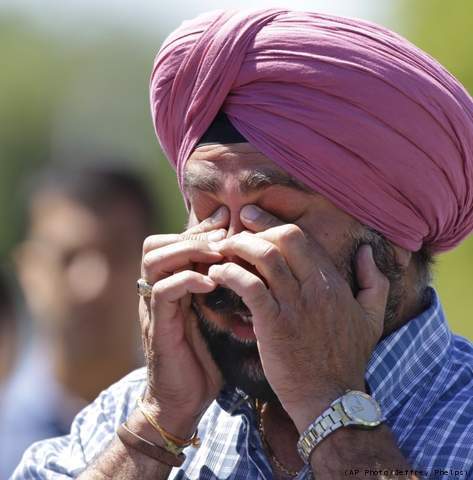 Over the past 12 hours #templeshooting has been covering the twittersphere. It is a reference to the tragedy that occurred early this morning in Oak Creek, Wisconsin, where a gunman entered a Gurdwara during Sunday divan and killed six sangat members, wounding many more. Sikhs around the country reacted almost immediately to this event – posting updates on Facebook and Twitter, speaking to news outlets, filling in gaps of misinfomation, supporting Sikh organizations who have been working diligently with local officials and government agencies and community members who started up a fund for the families of the victims. While this has been an incredibly traumatic experience for the Sikh American community, we are inspired by the actions of the police officer who came to the aid of the sangat members – potentially preventing a larger massacre. We are comforted by the support of our friends and colleagues who have reached out to the Sikh community offering their solidarity.
Over the past 12 hours #templeshooting has been covering the twittersphere. It is a reference to the tragedy that occurred early this morning in Oak Creek, Wisconsin, where a gunman entered a Gurdwara during Sunday divan and killed six sangat members, wounding many more. Sikhs around the country reacted almost immediately to this event – posting updates on Facebook and Twitter, speaking to news outlets, filling in gaps of misinfomation, supporting Sikh organizations who have been working diligently with local officials and government agencies and community members who started up a fund for the families of the victims. While this has been an incredibly traumatic experience for the Sikh American community, we are inspired by the actions of the police officer who came to the aid of the sangat members – potentially preventing a larger massacre. We are comforted by the support of our friends and colleagues who have reached out to the Sikh community offering their solidarity.
Here we have started a running list of articles, resources and community gatherings. We hope this will be a way for you to learn about the events and about ways for you to stay engaged.
Sikh comedians like Jus Reign have been gaining popularity through YouTube and social media sites for the last several years. I love being at gatherings of extended family when my little cousins show me the latest viral video, which often is hilarious. Even when it’s not, I find myself wondering what it would have been like to grow up as a Sikh in the diaspora in times like these. While we are still by and large not represented at all in the mainstream media, young Sikhs now create our own media, and many do so with much success. Sometimes the videos are brilliant, and perhaps sometimes they get hits simply because Sikhs in the diaspora, especially young Sikhs, are thirsty for the latest quirky, bizarre, or silly video put out by other Sikhs.
To end this hot and humid summer week in NYC, I thought I’d share this video that has been circulating lately, a trailer for what appears to be a series called “Sikhs in the City,” brought to us by Laughistan. There are some familiar faces in there including Sikh Coalition co-founder Amardeep Singh. I’m eager to see what their series will bring us in the future. Enjoy!
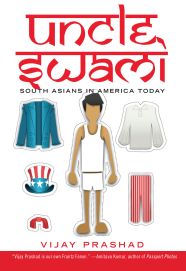
Co-blogged by Jodha and Mewa.
See introduction here.
In order to give some format to this, I’ll attempt to summarize major points of each chapter and then conclude the post with a bit of my own thoughts, analysis, questions, and/or comments. Looking forward to your comments and thoughts! We’ll see how it goes for this first time and can revisit the format, if need be.
Chapter 1 – Letter to Uncle Swami
Professor Vijay Prasad opens his Uncle Swami with a provoking letter to the Uncle. Uncle Swami may be the same as Uncle Sam or there may be some differences too. Prasad takes stock of the past 10 years since the “planes crashed into your buildings.”
Written in an anti-imperialist vein, he writes “planes crash; people are smashed.” The effects of that fateful September day were not limited to New York or Washington, to those nearly 3,000 people that died, or even their families. No, Prasad writes “your feet stomped on your own ground, crushing Balbir Singh Sodhi and Gurcharanjeet Singh Anand, Imran Tahir and Ahmed Abualeinen.” Nor were these feet only stomping on “your own ground” – they stomped “far-off Kabul and Kandahar, Mazar-e-Sharif, and Herat, later Baghdad and Basra.”
But that “obedient servant” knows that Uncle Swami isn’t just stomping feet and whipping tails, he acknowledges “You have been good to me. You have been good to many of us.” Still he suffers – “I have heartburn, Uncle. I will take to drink. I will take to drugs. I will take to watching TV, eating fast food, going into debt.”
Contradictions and all – this is Uncle Swami.
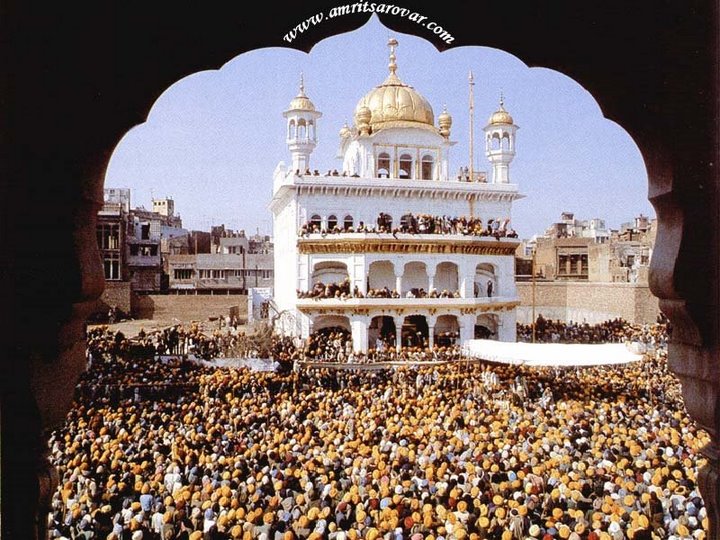 Guestblogged by Harinder Singh
Guestblogged by Harinder Singh
Harinder Singh is a co-founder of the Sikh Research Institute and the Panjab Digital Library. He is interested in anything Sikhi, esp. institutional development towards community building. His Twitter handle is @1Force.
I heard as recently as last Sunday at a Baltimore gurduara, that Sikhs don’t know how to make their own decisions. True, and false.
For more than a century (1699-1805), Sikhs made tough, controversial, politically incorrect, yet reached consensus-driven, time-sensitive, and decisive conclusions via the institutions of the Sarbat Khalsa and the Gurmata. And this was accomplished during a century that saw half of Sikh population killed in a single genocidal campaign.
It has taken more than 200 years to dismantle these systems of consensus building; it will take a concerted effort for at least 20 years to revive it. This process will require complete openness and inclusivity. It is a risk worth taking and a solemn opportunity to grasp what others deemed worth dying for!
Sikhs worldwide responded to the recent Rajoana phenomenon with stunning solidarity. Governments, politicians, and spiritualists weren’t sure what was going on. Musicians used the opportunity to wash-off their “sins” of sycophancy from the last Panjab election promos. People-at-large were excited, but they were not prepared. I felt personally that I failed to convince myself of what matters most, and I failed to convince the activists (both the Tweeting and sloganeering kinds) to do something meaningful in any concerted way. I concluded that we self-deluded panthak folks failed everyday-Sikhs at this historical moment with an engagement policy. There was no mechanism to decide what the Panth must do at the crucial tipping point of actionable potential.
By now, you have surely been inundated with Facebook posts and discussions expressing excitement, amazement, or maybe skepticism about French designer Jean Paul Gaultier’s recent showcase of (non-Sikh) models wearing colorful “Sikh-style” turbans.
Gaultier has a thing for India, it seems. According to a recent news article, “The designer is known to visit the country quite often and owns a vast library of intensely coloured textile swatches here since his first visit to Kolkata in West Bengal and Puri in Orissa, in the 1970s.” In a recent interview, Gaultier said, “In every collection I have done, there is always an Indian inspiration.”

Over the last couple of weeks, I’ve been fascinated by the buzz about the turbaned models in Sikh circles and have been trying to figure out exactly how I feel about it and if I have anything useful to contribute to the conversation. I can’t promise this will be useful, but here are some thoughts and questions that have been swirling around in my head lately.
We Sikh men are not used to being seen as attractive or desirable through the lens of mass media. In Bollywood we are buffoons, in Hollywood we are nonexistent, save the English Patient and the occasional shoutout Waris Ahluwalia gets in the press. So yes, there is something amazing about seeing these models rocking turbans like they are the hottest accessories imaginable, when we, for so long, have received little to no positive reinforcement from the mainstream.
 It has been nearly four years since we last attempted this. Back then, we attempted TLH’s very first book club, by examining Gurharpal Singh’s and Darshan Singh Tatla’s Sikhs in Britain: The Making of a Community. This round we are suggesting Vijay Prasad’s Uncle Swami.
It has been nearly four years since we last attempted this. Back then, we attempted TLH’s very first book club, by examining Gurharpal Singh’s and Darshan Singh Tatla’s Sikhs in Britain: The Making of a Community. This round we are suggesting Vijay Prasad’s Uncle Swami.
Although the book is aimed at issues centered around South Asian American experiences, it may be useful and enlightening to see how well they fit, shape, and interest Sikh-American experiences.
The Book:
From the jacket:
Within hours of the attacks on the World Trade Center, misdirected assaults on Sikhs and other South Asians flared in communities across the nation, serving as harbingers of a more suspicious, less discerning, and increasingly fearful worldview that would drastically change ideas of belonging and acceptance in America.
Weaving together distinct strands of recent South Asian immigration to the United States, Uncle Swami creates a richly textured discussion of a diverse and dynamic people whose identities are all too often lumped together, glossed over, or simply misunderstood. Continuing the conversation sparked by his celebrated work The Karma of Brown Folk, Prashad confronts the experience of migration across an expanse of generations and class divisions, from the birth of political activism among second-generation immigrants and the meteoric rise of South Asian American politicians in Republican circles to migrant workers, who are at the mercy of the vicissitudes of the American free market.
A powerful new indictment of cultural and racial politics in America at the dawn of the twenty-first century, Uncle Swami restores a diasporic community to its full-fledged complexity, beyond both model minorities and the specters of terrorism.
The Author:
For those interested in issues related to South Asian Americans, Professor Vijay Prasad needs little introduction. The author of The Karma of Brown Folks has been one of the foremost thinkers and scholars on the subject of identity politics and identity formation of South Asians in the Unitd States.
There has been plenty of criticism of his politics, book, and writings. All of these are pertinent and can allow for a more nuanced discussion. Still his voice is important and calls out for discussion.
The Format:
- Part 1 (Monday, 7/16) – Chapter 1 (Letter to Uncle Swami) and Chapter 2 (The Day Our Probation Ended)
- Part 2 (Monday, 7/23) – Chapter 3 (The India Lobby) and Chapter 4 (How Hindus Became Jews)
- Part 3 (Monday, 7/30) – Chapter 5 (Compulsions of Ethnicity) and Chapter 6 (The Honeycomb Comes Apart)
What to do from here:
- Order the book ASAP. Don’t delay as we are going to begin in one week.
- Invite others and help us spread the word!
- If you are going to participate, leave a short introduction here in the comment section and let us know that you plan to take part.
- Be ready in 1 week!
My Facebook news feed and email inbox have been buzzing with discussion and calls to action to challenge racial profiling and, in particular, the NYPD’s infamous “stop and frisk” policy. I was happy to receive multiple emails today on the issue from Sikh American civil rights organizations, namely SALDEF and the Sikh Coalition. I’ve previously written about my own experiences with racial/religious profiling in NYC and the importance for us Sikhs to make the connection between the profiling we face post-9/11 and the profiling young black and Latinos have been enduring for decades.
Encouraging the NY Sikh community to attend a massive silent march this Sunday (father’s day, not coincidentally), the Sikh Coalition’s email alert stated:
In the post 9/11 era, Sikhs know all too well the consequences of racial profiling. We have felt the violence of profiling at airports; it is humiliating. It is a violation of our civil rights and it severely undermines our liberty and our safety.
As Sikhs, we have an obligation to stand for the human rights of all people. It is important that we uphold this sacred commitment as African American and Latino communities endure the type of unfair scrutiny that leads to hate crimes, workplace discrimination, school bullying, and profiling.
Co-blogged by Sundari and American Turban
Likely unbeknownst to many Sikhs, last Friday marked a historic moment for America’s Sikh community.
Around 7:30am on that day, about 50 people representing Sikh communities from across the country – California, Texas, Indiana, Ohio, Michigan, Georgia, New York, New Jersey – gathered at the East Wing for a special tour of the White House. These members of the community walked through the historic center of the country, seeing with their own eyes notable places such as the room in which President Thomas Jefferson first held cabinet meetings and the Blue Room which remains the reception room of the White House. Following the tour, community members joined White House administrators for the first-ever White House briefing on Sikh civil rights issues.
For those of us in the audience, it was a deeply moving moment – particularly when the briefing started out with Bole So Nihaal, Sat Sri Akal. Yes, a jakara in the White House!
There was something symbolic in that moment. Once, a long time ago, Sikhs would have made the jakara call while raising their flag at the Red Fort in Delhi, the symbolic capital of India, as Jassa Singh Ahluwalia was proclaimed Sultan-e-Quam (‘king of the nation’) – a gesture in which Sikhs laid claim to their sovereignty as a people in 19th century India. Now, under certainly different circumstances in a land separated by time and distance, Sikhs were making a similar call to claim to their legitimacy as Americans.

“But, when you have a beard, a mustache, it’s like a mask. You can’t see the person’s face. It’s hidden.”
As disagreeable as the words sounded, my friend’s tone was very gentle and civil. It was almost as if he was asking me the question: why bother?
I was a nine-year-old Sikh boy with a little mustache fuzz and a patka (a Sikh boy’s headcovering), speaking with the clean-shaven teenaged Hindu boy next door whom I befriended on this extended trip to India. I would often play games with his younger brother, but with this older brother, our interaction usually took the form of conversations about our different cultures and religions.
His point about hair left me somewhat at a loss. I remember his facial expression after he made his statement – curiously waiting for a response that I would not have.
Later that evening, I presented this argument to my father. “He said people can’t see our true faces because of the hair on our face.”
My father didn’t take a second to respond. “This is my face”, he said very matter-of-factly, “this is how a man’s face naturally looks.”
Guest blogged by Naujawani Sardar
 Sikhs in the UK celebrated a victory of sorts today with the news that the national broadcaster, the BBC, ‘regretted’ comments made by a presenter on their digital radio station, the BBC Asian Network. On 13 March, DJ Nihal Arthanayake had suggested on his daily call-in show that Sikhi was “made up from other religions i.e. Islam and Hinduism” [see related article]. When corrected by a listener who texted in to challenge the presenter’s comments, Nihal showed shocking arrogance in asserting that he himself was correct and replied that he knew “more about your religion than you do”. But today’s news is only a victory of sorts with Lord Inderjit Singh of the Network of Sikh Organisations describing it as “not a very good sorry” and in this writer’s humble opinion, a mere bone to keep us from tackling the real problem.
Sikhs in the UK celebrated a victory of sorts today with the news that the national broadcaster, the BBC, ‘regretted’ comments made by a presenter on their digital radio station, the BBC Asian Network. On 13 March, DJ Nihal Arthanayake had suggested on his daily call-in show that Sikhi was “made up from other religions i.e. Islam and Hinduism” [see related article]. When corrected by a listener who texted in to challenge the presenter’s comments, Nihal showed shocking arrogance in asserting that he himself was correct and replied that he knew “more about your religion than you do”. But today’s news is only a victory of sorts with Lord Inderjit Singh of the Network of Sikh Organisations describing it as “not a very good sorry” and in this writer’s humble opinion, a mere bone to keep us from tackling the real problem.
The daily call-in show on the BBC Asian Network has been steadily gaining in notoriety over the last 18 months fuelled largely by an increasing move towards discussions that court controversy. From 1pm-3pm, Monday to Friday, listeners tune in to hear the presenter, callers and occasionally guests debate a topical issue that is usually relating to a section of the South Asian community, followed by a sparse selection of music and further, more light-hearted discussion. Sometimes the initial debates have been incredibly engaging and informative, on other occasions they are needlessly provocative and disparaging.
In recent months, I have been called upon as a contributor to the show a handful of times, speaking live on air as a Sikh voice and I have publicly commended the production team of the show on two separate occasions for talking about challenging issues that are otherwise ignored by mainstream media. Following a discussion show about the recent Immortal Productions release ‘Jaago’ , a show to which I contributed by a pre-arranged telephone call, I took to Twitter to voice how fair I thought the production team had been in allowing Sikhs such as myself to make our voices heard about the rife corruption, inequality and poverty prevalent in the Indian State of Punjab over the last sixty years. Having been in Sikh political circles for over two decades now, I was unsurprised by the immediate level of hate I received from fellow Sikhs for being seen to ‘support’ Nihal and the BBC Asian Network on that occasion, but it did make me realise that Nihal in particular seemed to be drawing much of the ire. Whilst this is to some extent deserved, it would be foolish to reason that replacing the presenter might provide scope to change direction. But this is a difficult reality to impart upon a very unforgiving Sikh diaspora. I made the mistake of trying to explain to a young Sikh female on Facebook that a presenter of a call-in show usually acts in accordance with the briefing given to them by the production team, who in-turn are loosely guided by the direction given to them from the station controller or management, and that if she did have any complaints here they ought best be directed towards the BBC as well as the individual. She proceeded to reply that I must be a blind fan of Nihal’s and was planning on giving him a siropa. Oh the joys of ‘debating’ on social media(!)
